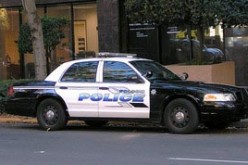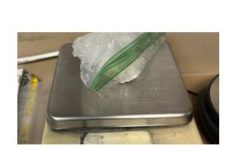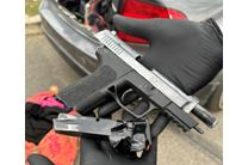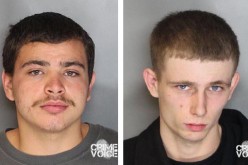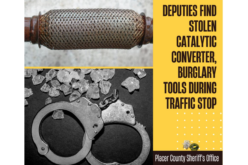Roseville man latest to fall for growing laser crime
 SACRAMENTO — It’s not a widely publicized crime but, according to federal aviation officials, “lasering” is dangerous enough to deserve more of the proverbial spotlight than it’s getting.
SACRAMENTO — It’s not a widely publicized crime but, according to federal aviation officials, “lasering” is dangerous enough to deserve more of the proverbial spotlight than it’s getting.
A Roseville man was the latest to be convicted of the offense, sentenced Tuesday to more than three years in federal prison for shining a high-powered green laser at an airborne Sacramento sheriff’s helicopter in March.
Balltazar O. Valladares, 30, joins a growing number of reported cases in which individuals armed with high-powered lasers point them at traveling aircraft. Whether people are committing this crime out of malice, boredom or ignorance, Ian Gregor doesn’t know.
Gregor, communications manager for the Federal Aviation Administration’s Western-Pacific Region, simply knows the number of laser reports to his agency has jumped exponentially in recent years, from about 300 reported cases in 2005 to more than 750 last year. The FAA is on track to eclipse last year’s mark, having already received more than 730 laser reports through July of this year.
“We don’t know if the increase in reports is occurring because pilots are becoming more diligent in reporting these incidents or because more people are engaging in this type of dangerous and irresponsible behavior,” Gregor said.
Because of the jump in incidence, the FAA several years ago began requiring air traffic control facilities to immediately contact local law enforcement when they receive laser reports from pilots.
That’s what put law enforcement on the trail of Valladares on the night of March 16, when a Southwest Airlines plane landing at Sacramento International Airport was hit by a green flashing laser light while flying over Roseville.
Police dispatched to the area were unable to locate the source of the laser. But about two hours later, a helicopter with the Sacramento County Sheriff’s Department was hit with a similar high-powered laser. The department’s Air Unit Star 5 flew in the direction of the light, coming within a half-mile of the source: the exterior of a small cottage near the back of a small apartment complex in the 100 block of Elm Street.
Roseville police officers arrived at the cottage belonging to Valladares, who initially denied knowing anything about a laser device. With Valladares on probation for drug charges, police were able to search his home, finding the laser in two pieces hidden in different parts of the defendant’s room.
According to the U.S. Department of Justice, the laser was seven times more powerful than the standards published by the Food and Drug Administration. DOJ says high-powered lasers like the one used by Valladares have the potential to blind those who may look at it. As it concerns aircraft, the laser may interfere with pilots several kilometers away and can cause problems during critical phases of an aircraft’s operation, including takeoffs and landings.
Valladares was arrested and later admitted shining the laser at the police helicopter, which he referred to as a “ghetto bird,” but denied shining it at the Southwest plane.
Valladares pled guilty in June to one count of interfering with the safe operation of an aircraft. He was sentenced to three years and one month in prison, and three years of supervised release.
“These years in federal prison should give anyone pause when contemplating as reckless an act as potentially blinding a pilot who is operating an aircraft,” U.S. Attorney Lawrence G. Brown said in a statement.
Gregor explained that people can face stiff penalties if convicted of pointing lasers at aircraft. Many local governments have ordinances making it illegal to shine lasers at aircraft, he said. In California, people convicted of pointing lasers at aircraft can face penalties of up to three years in prison and a $2,000 fine. Perpetrators can also face federal charges.
“Anecdotally, it seems to me that I’m hearing of more instances in which police make arrests in laser incidents,” Gregor said.
Aside from Valladares, recent arrests in the Western-Pacific Region include:
• In December 2008, police arrested five juveniles, aged 13 to 16, on felony counts of shining a laser at a police helicopter near Bob Hope Airport in Burbank.
• Also in December 2008, a 35-year-old Newport Beach man agreed to a two-year prison sentence in exchange for pleading guilty to four counts of pointing a laser at a police helicopter and drug possession.
• In October 2008, a 28-year-old Bakersfield man was sentenced to two years in prison for shining a laser into the cockpit of a Kern County Sheriff’s Department helicopter.
• In October 2007, Los Angeles police arrested a juvenile for pointing a red laser at an LAPD helicopter as it flew above Van Nuys. The beam struck the flight officer in the face.
As for motive, authorities say that can be difficult to pin down. In some instances, Gregor said perpetrators had consumed alcohol. In other cases, those arrested were teenagers.
According to the criminal complaint written by Federal Air Marshal Timothy L. Childs, Valladares said he would entertain himself by shining the laser “on various objects around Roseville” late at night.
Gregor wasn’t aware of any cases in the Western-Pacific region where authorities determined that somebody was deliberately trying to blind a pilot or bring down an aircraft.
“Fortunately, no aircraft has crashed yet as a result of a laser event,” he added.
In sentencing Valladares, U.S. District Judge William B. Shubb acknowledged the defendant’s “apparently sincere indication to turn his life around,” but said it was important to send the message that shining a laser at aircraft in flight is a “very serious problem (with) very, very serious consequences.”

